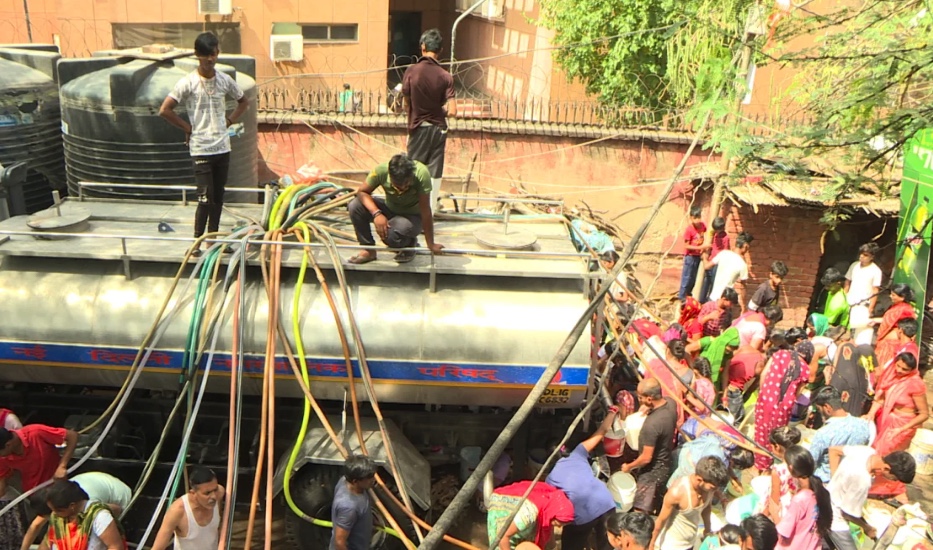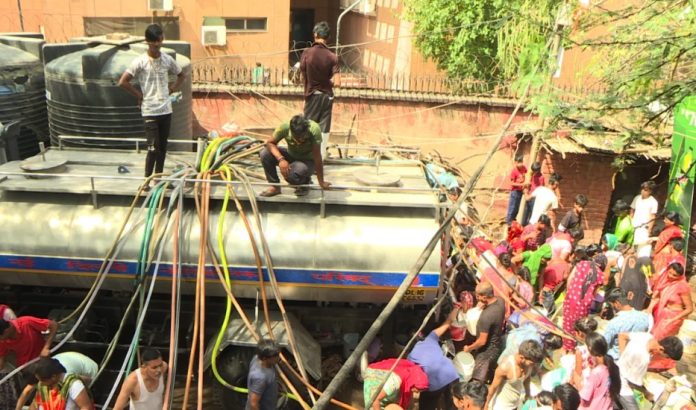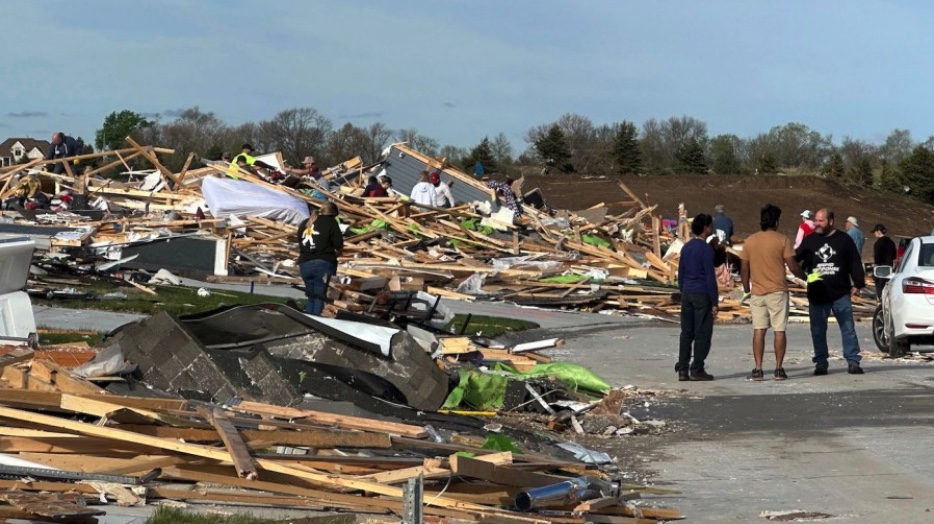ในสลัม Chanakyapuri ในเดลี ท่ามกลางความร้อนทำลายสถิติที่ 49.9°C (121°F) จะไม่มีน้ำจืด และพระอาทิตย์แผดเผาหลังคาดีบุก ขณะที่ชาวบ้านดิ้นรนแย่งชิงน้ำไปส่งน้ำ ผู้คนหลายสิบคนรีบไปที่รถบรรทุก แต่หลายคน รวมทั้งแม่ลูกหก Poonam Shah ต่างจากไปมือเปล่า “ครอบครัวของฉันมี 10 คน เราทุกคนสามารถอาบน้ำด้วยน้ำเพียงถังเดียวได้ไหม” เธอถาม Poonam กำลังทำงานอยู่ตอนที่รถน้ำมาถึง พอกลับมาน้ำก็หมด เธอเล่าถึงเหตุการณ์ที่เธอต้องเผชิญกับอากาศที่ร้อน ในขณะที่ความร้อนปกคลุมทางตอนเหนือของอินเดียเป็นประวัติการณ์ รัฐบาลเดลีจัดสรรน้ำให้ฟรีเพื่อประชาชน ก่อนหน้านี้ละแวกบ้านPoonamได้รับเรือบรรทุกน้ำมันสองถึงสามลำต่อวัน แต่ตอนนี้เหลือเพียงลำเดียวเท่านั้น อุณหภูมิในเดลีสูงเหนือ 40 องศาเซลเซียสอย่างต่อเนื่องในช่วงสัปดาห์ที่ผ่านมา โดยแตะระดับสูงสุดเป็นประวัติการณ์ที่ 49.9 องศาเซลเซียสในพื้นที่หนึ่งเมื่อวันอังคาร ตามการระบุของกรมอุตุนิยมวิทยาของอินเดีย
มีรายงานผู้เสียชีวิตอย่างน้อย 1 รายในเดลี และอีกหลายสิบรายทั่วประเทศเนื่องจากอากาศร้อน โรงพยาบาล Ram Manohar Lohia (RML) ในเดลีกำลังรักษาผู้ป่วยที่เป็นโรคลมแดดขั้นรุนแรง (heatstroke) อ่อนเพลีย และขาดน้ำเพิ่มขึ้นจำนวนมากขึ้นโดยใช้ถังแช่เย็น ทรัพยากรของโรงพยาบาลสามารถช่วยคนเพียงไม่กี่ล้านคนที่อดทนต่อความร้อนอบอ้าวของกรุงเดลีได้ ผู้เสียชีวิตเป็นแรงงานต่างด้าว อายุ 40 ปี ยอมทนร้อนหลังเข้ารับการรักษา ผู้ป่วยโรคลมแดดส่วนใหญ่ที่โรงพยาบาลมาจากชุมชนที่ยากจนกว่า และถูกบังคับให้ต้องทำงานกลางแดดเป็นเวลานานหลายชั่วโมง ตัวอย่างเช่น Kali Prasad ขายน้ำและน้ำมะนาวใกล้ประตูอินเดีย โดยเข็นรถเข็นของเขาวันละแปดกิโลเมตร เขาต้องยืนกลางแสงแดดที่แผดจ้าตลอดทั้งวันเพื่อเลี้ยงดูครอบครัว
ในช่วงไม่กี่ปีที่ผ่านมา ความร้อนในฤดูร้อนมาถึงเร็วกว่าปกติ โดยอุณหภูมิจะสูงขึ้นและคลื่นความร้อนก็ยาวขึ้น ทางตะวันตกเฉียงเหนือและตอนกลางของอินเดียมีอุณหภูมิสูงสุดเกิน 42 องศาเซลเซียส โดยบางเมืองมีอุณหภูมิสูงเกิน 50 องศา ตามข้อมูลจากกรมอุตุนิยมวิทยาของอินเดีย แนวโน้มนี้เป็น “การแสดงให้เห็นอย่างชัดเจนถึงผลกระทบที่เพิ่มขึ้นจากการเปลี่ยนแปลงสภาพภูมิอากาศ” Farwa Aamer ผู้อำนวยการโครงการริเริ่มเอเชียใต้ของสถาบันนโยบายสังคมเอเชีย กล่าว Aamer เน้นย้ำถึงความจำเป็นเร่งด่วนสำหรับกลยุทธ์การปรับตัวที่แข็งแกร่งและมาตรการเชิงรุกเพื่อปกป้องชีวิตและการดำรงชีวิต โดยเฉพาะอย่างยิ่งในกลุ่มประชากรที่อ่อนแอ จากผลกระทบร้ายแรงด้านสุขภาพจากความร้อนจัด สำหรับหลายๆ คนในเดลี วิกฤตสภาพภูมิอากาศทำให้ฤดูร้อนทนไม่ไหว
India’s scorching heat and water shortages leave Delhi’s poor to bear the brunt of the climate crisis.

In Delhi’s Chanakyapuri slums, there’s no fresh water amid record-breaking heat of 49.9°C (121°F). The sun scorches tin roofs as desperate residents scramble for water deliveries. Dozens rush to the truck, but many, including mother-of-six Poonam Shah, leave empty-handed. “There are 10 people in my family – can we all bathe with just one bucket of water?” she asks. Poonam was working when the water truck arrived. By the time she returned, the water was gone. As record heat grips northern India, the Delhi government has been forced to ration free water deliveries. Poonam’s neighbourhood previously received two to three tanker deliveries per day, but now it’s down to just one. Temperatures in Delhi have consistently hovered above 40 degrees Celsius over the past week, reaching an all-time high of 49.9 degrees Celsius in one area on Tuesday, according to the Indian Meteorological Department.
At least one death has been reported in Delhi and dozens more across the country due to the heat. Ram Manohar Lohia (RML) Hospital in Delhi is treating a growing number of patients with extreme heatstroke, exhaustion, and dehydration using cold immersion tanks. The hospital’s resources can help only a few of the millions enduring Delhi’s heat, provided they arrive quickly. The deceased patient was a 40-year-old migrant labourer who succumbed to the heat after being admitted. Most heat stroke patients at the hospital are from poorer communities, forced to work long hours in the sun. For instance, Kali Prasad sells water and lemon juice near India Gate, pushing his cart eight kilometres daily. He must stand in the scorching sun all day to support his family.
In recent years, summer heat has arrived earlier, with temperatures climbing higher and heatwaves lengthening. Northwest and central India have seen maximum temperatures above 42 degrees Celsius, with some towns surpassing 50 degrees, per the Indian Meteorological Department. This trend is “a clear manifestation of the escalating impacts of climate change,” says Farwa Aamer, director of South Asia initiatives at the Asia Society Policy Institute. Aamer emphasises the urgent need for robust adaptation strategies and proactive measures to protect lives and livelihoods, especially among vulnerable populations, from the devastating health effects of intense heat. For many in Delhi, the climate crisis has already made summer unbearable.
By CNN NEWS

















